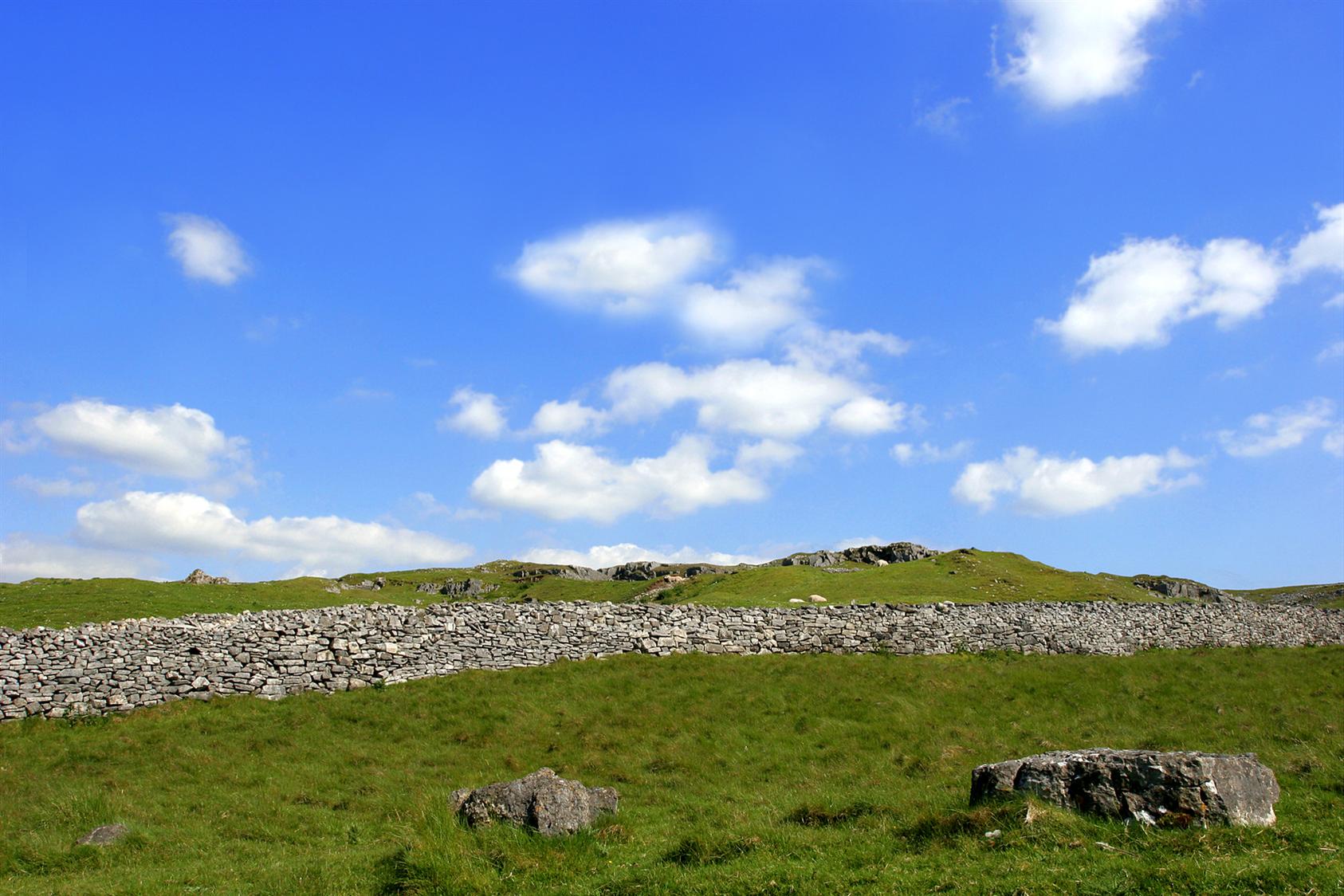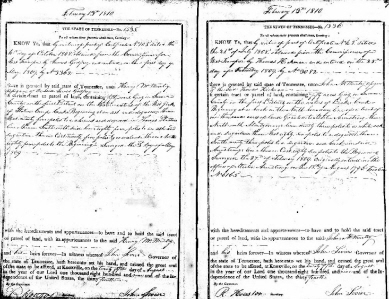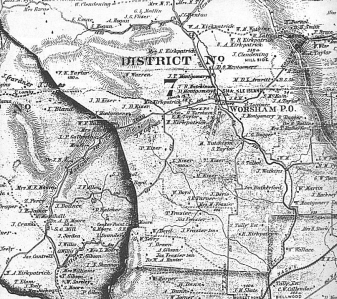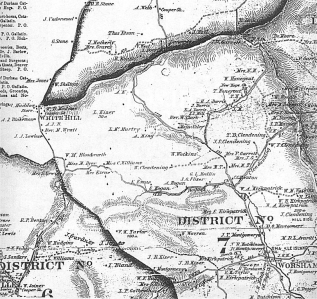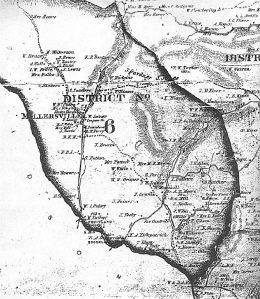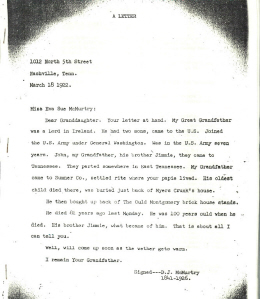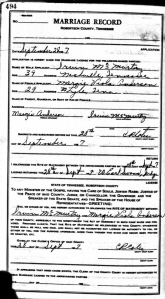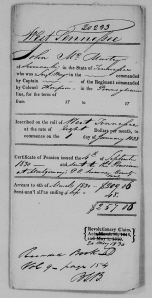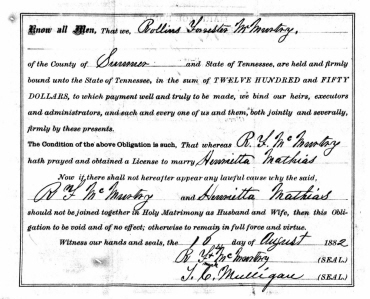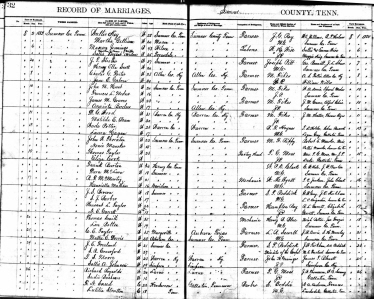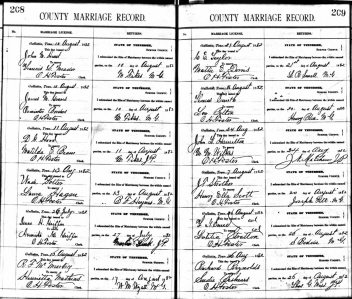McMurtry Family Website for the Descendants of John McMurtry (1752 to 1841)
This document is transcribed (as originally written) from an article in the Nashville Suburban Newspaper Gazette on Mar. 26, 1980. It was written by Otis D. McMurtry of Mt. Juliet, TN and is named Great, Great Grandfather vs. The Redcoats.
This is being documented for posterity and is a great story, enjoy it. Bruce Miller
Great, Great Grandfather vs. The Red Coats 1775-1780
With all the genealogical interest generated by Mr. Haley’s “Roots” and the interest being shown in Historical Events, prompts me to write of Great, Great Grandfather John, as related to me: in part by the “old ones” over the years.
He was not a famous man neither was he a slave holder nor did he ever own a big brick house and/or did he ever claim to have built the first grist mill in the county.
Great, Great Grandfather John was born 15 February 1752 (53), in the province of New Jersey, of humble origin.
He was a son of James the eldest son of Thomas and wife, Mary, who came with his brothers Joseph and Robert and two (2) sisters to Morris County, New Jersey in1720. They were Scotch Irish, said to be from North Ireland.
In the year, 1752, the English government found the calendar in use at the time to be in error. Eleven days had been lost and in the process of corrections New Years Day was set back from March 25th under the old calendar to January 1st as at present. Great, great grandfather was perplexed and he so noted in his Family Bible; to wit: John McMurtry, Sr., born February 15, 1752(53). (see page of Family Record insert.)
The winds of time blew and when about the age 22 or 23, (July 1775) great, great grandfather found himself in Washington’s Army as a private soldier of the First Pennsylvania Regiment, in line of battle at The Siege of Boston. His regiment having marched from Carlisle, County Town of Cumberland County, Pennsylvania, some 432 miles and then it was said that Captain James Chambers in his report stated. “I crossed the Hudson River at a place called West Point with my ninety men on the march to Boston”
When the siege was lifted in the spring of 1776, great, great grandfather marched south with Washington’s army to New York City and there, 22nd October, he fought the Battle of Long Island. Later in October he fought the Battle of White Plains.
He retreated with the balance of the army through the Jerseys and across the Delaware and when the snows came in the winter of 1776, Washington’s army was down to 3,000 men including great, great grandfather John.
Having gained some new enlistments to the extent that his forces now numbered about 7,000 men. Washington decided to re-cross the Delaware and so it was that great, great grandfather stood at McConkey’s Ferry, Christmas Day 1776, to be ferried through the ice floes to fight the hated Hessians at the Battle of Trenton. Of a total of 1,400, 918 of these Hessians were captured. So Washington, after this success, ferried his army back to the Pennsylvania side of the Delaware.
Encouraged by the victory at Trenton, Washington again, 31 December 1776, re-crossed the Delaware and great, great grandfather stood once again in the line of battle and on 3 January 1777, he fought the Battle of Princeton in which the British were put to flight. After this battle, the army went into winter quarters at Morristown, New Jersey. For the next six (6) months the whole front was quiet with the two (2) armies engaging only in various maneuvers in New Jersey.
Finally in mid August 1777, General Howe, the British Commander, retired to New York, placed his army aboard ship and sailed down the coast and up the Chesapeake Bay in an attempt to capture Philadelphia.
Again general Washington crossed the Delaware and positioned his army of about 11,000 men athwart the main road to Philadelphia and here, 11 September, great, great grandfather fought the Battles of Chad’s Ford and Paoli where the Americans were bayoneted in the night.
Washington retreated and Philadelphia was lost. In the early Hours of 4 October 1777, Washington again attacked the British and once again great, great grandfather stood in the line of battle and he fought the Battles of the Brandywine and Germantown.
Washington then moved into winter quarters at Valley Forge, which is mainly remembered today for the patriotism, perseverance and devotion to duty of the small body of officers and men, less then 6,000 in all, that stayed with the army during this winter of suffering in 1777-1778.
About this time, in February 1778, Washington acquired the services of an old retired Prussian Captain, Frederick Wilhelm Von Steuben to train his army and instill some discipline, which he proceeded to do so well that right away he was promoted to Inspector General.
It is said the old general could speak no English other than a few “cuss” words, to the amusement of the troops.
At about this time great, great grandfather had been promoted from Sergeant to Sergeant Major in the First Pennsylvania Regiment, and no doubt he barked the orders of “Old Von Steuben”, at least those he could understand.
The last major battle in the north was the Battle of Monmouth after which there developed a stalemate and great, great grandfather found himself a supernumerary officer. He had been promoted to Ensign and had been recommended for Lieutenant by Colonel James Chambers.
So, as of August 1780, five years after enlisting, great, great grandfather John resigned the army. (One would think to go home but NO!) He went down to Philadelphia and signed on board “The Fair American” a brig carrying 16 six (6) pounders being a Privateer, commissioned by the state of Pennsylvania and commanded by Captain Decatur. How long he went “a privateering”, as William Montgomery, Esq. Described in his affidavit of 1828, we have no record.
The urge to return home finally prevailed and as of 29 January, 1781, in Somerset County, New Jersey, a marriage license was issued for marriage between John McMurtry and Margaret Gomer, a daughter of Henry and Mary (Dorris) Gomer, said to be a daughter of William Dorris (or Granddaughter) an immigrant from County Down, Ireland.
The migration was to the south at that time, the war being over so, about 1785-86 great, great grandfather, probably in company with his brother James, Jr., sister Jane, Alexander Kirkpatrick and some of the Dorris’ et al head South to Orange County, North Carolina.
In that year, great, great grandfather purchased the150 acres from John Walraven located on Scrub Creek, a branch of Quaker Creek, which is now (1980) in Alamance County being taken out of Orange County.
Familiar Sumter County, Tennessee, names show up in Orange County, North Carolina: viz. Hunnicutt, Kirkpatrick, Garrett, Garrison, Lowery and others.
By 1793 the Indian Wars were coming to a close in the Tennessee Country and this combined with the desire for cheap land created a migration westward, plus the fact that a road for horseback at least, was being cut or had been cut into the Middle Tennessee Country.
By 1793 great, great grandfather sold his 150 acres to Isaac Dorris and in company with others he headed westward with his family, which now consisted of wife Peggy, Henry, age 12, Jenny, age 9 (she later married John Garrett), John, Jr., age 6, James, age 4, who died on Drakes Creek in 1795. Four more Children, Mary, born 1796, Thomas Wilkerson, born 1802 and Peggy, born 1806, were born in Sumner County, Tennessee.
This little group came across the mountains, probably through the village of Knoxville and crossed the Cumberland River at Flynn’s Ferry now in Jackson County and onward to the vicinity of Dixon Springs and finally into the buffalo path at Bledsoe’s Lick, now Castalian Springs. Trailing the buffalo path through or close to what is now Gallatin, Tennessee, they passed the spot where a contemporary John McMurtry, a young man of East Tennessee and Botetourt County, Virginia, son of Joseph, was killed by the Indians while trailing the buffalo path from Manskers Station to Bledsoe’s Station in company with General Daniel Smith, about 1782, General Smith was injured.
Passing the present site of Gallatin the trail veered westward and about 7 miles further they crossed Drakes Creek into a dusty little cross roads (already sparsely settled by William Montgomery, Francis Ketring, et al) probably named for Philip Schackler, the first land owner ( in 1788 he paid taxes on 6073 acres) and due to the creek forming an island there, it became known as Shackle Island.
Tradition has it that great, great grandfather went up Drakes Creek one and one half (1 ½ ) miles and built a thatch top house on the bank of the creek with an escape tunnel to the creek. Great uncle John, the Indian fighter, born in 1846, (Ezell’s grandfather) pointed out the spot years ago to Jacob Taylor McMurtry, as being about 100 yards directly in front of his (J.T. McMurtry) house. The creek has since changed its course.
In 1797 great, great grandfather purchased 83 acres to the rear of Ole Beech Cumberland Presbyterian Church (yet to be established in 1798) from Edward Gwinn. Future grants from the State of Tennessee increased the size of his plantation to about 645 acres.
In 1799 great, great grandfather was appointed Magistrate (during good behavior) by John Sevier, First governor of the new State of Tennessee. In 1809 he was appointed coroner of Sumner County.
In the previous year (1798) Ole Beech Church was organized. James Kirkpatrick and John McMurtry were named as trustees in the transaction whereby William Montgomery and Francis Ketring conveyed 1 acre for a church and burying ground.
The winds of time blew and by 1828 the federal government had authorized pensions for the remaining veterans of the Revolutionary War, under strict rules of eligibility.
Great, great grandfather applied and was finally awarded a pension of $8.00 per month to be delivered to Montgomery’s Post Office, but only after the strict requirements of the War Department were met, which resulted in a number of affidavits being filed, to wit;
1. James Frazor- acquaintance of 25 years Daniel Latimer, J.P.
2. William Montgomery, Esq., acquaintance since 1797 as neighbor. William states, “ I, being a citizen of Pennsylvania in the time of the Revolutionary War and frequently out in Militia Service we talked over the scenes of the War.” Clarence Watkins, J.P.
3. Hugh Kirkpatrick- acquainted since 1798. William Montgomery, J.P.
4. Peter Ketring- acquainted for more than 30 years.
5. Shadrech Nye- for 30 years.
6. James Garrett- relates that he had been at sea in time of War.
7. Joshua Hadley, an officer of North Carolina troops state that he saw John McMurtry at the Battle of Germantown under the direct command of General Washington.
On 6 September 1831, great, great grandfather made his will naming his wife, Peggy, and
children; Henry, John Jr., Jenny (John) Garrett, Polly (Jacob) Forrester, Asa and Thomas Wilkerson McMurtry. With the provision that in the event his wife Peggy, remarried she could only have the mare called “Fly”, with bed and bedding and would leave the plantation with her new husband. Executors, Asa McMurtry, Thomas W. McMurtry and Samuel Kirkpatrick. Witnesses: Hugh Kirkpatrick, Benjamin Taylor and William Lowery. After the death of her husband in 1841, Peggy applied for a widow’s pension and was rejected on a technicality. Finally after much correspondence a “special” bill was presented to the United States House of Representatives 8 March 1842, by U.S. Rep. Cambell; “and they accordingly report a bill for her relief.” She remained a widow until her death in 1846.
As related by the “Old Ones” Montgomery’s Post Office must have been located in front of Old Beech Church and of course the community gathering place, especially the “Old Ones” of leisure. Here no doubt, the tall tales were told, the “Old Ones” relating their experiences and the young ones listening as I did years ago. To wit: John McMurtry as to how he accidentally shop and killed John Penn on the march to Boston: Bartlett Hunnicutt, as to how he, Adey and Bracey Hunnicutt, along with Henry and John McMurtry, Jr., mounted’ their horses as mounted gunmen, September 1814, and headed south down the Natchez Trace to fight the Battle of New Orleans. “Jake Forrester” was also there.
John and James, sons of James McMurtry, Jr., (brother to great, great grandfather John) who had gone to Humphreys County, Tennessee, about1810, were both lost in the Battle of New Orleans. One of these had at least two children, James and Elizabeth (Tuggle), who later resided in McCracken County, Kentucky, as brother and sister.
Then no doubt, prior to his death in 1825, Alexander Kirkpatrick, Sr., would ride down from his large plantation in Wilson County, just across the Cumberland River from the present Gallatin Steam Plant to visit his sons, Hugh, James and Alexander, Jr. (deceased 1807) et al.
Old Casper Mansker, I’m sure would ride down the pike occasionally and stop and things would no doubt “liven up” when the old Indian fighter was present and so on and so on.
Now to indulge in a bit of genealogy: Alexander Kirkpatrick, Sr. begat a son James, who begat a son Samuel, 1798, who begat a daughter Margaret who married Marion McMurtry (Son of Asa) who begat a son Asa W., who begat a son George Herman McMurtry, the bridge builder and former official of Goodlettsville.
Bartlett Hunnicutt begat a son Preston (1822), who begat a son William Preston, who begat a son Jeff, who begat a son Jack Hunnicutt, now Chief of Police of your city of Goodlettsville, Tennessee.
William Dorris born 1761, Hopewell Township, Hunterdon County, New Jersey (was also a soldier in the Revolutionary war)(see Pension #W916). He served as a member of the New Jersey State Militia and migrated to Caswell County, North Carolina, where he later married Eleanor Brown, 1785, a daughter of Leonard Brown. William came to Sumner County, Tennessee about 1802 and resided near Fountain Heat until his death in 1842.
John and Jane Dorris begat a daughter Martha Jane, born 4 December 1824, who married, 1845, Robertson County, Tennessee, Preston Hunnicutt, a son of Bartlett. This noble couple begat a daughter, Sarah Jane Hunnicutt, who married, 1865, Daniel Jefferson McMurtry, a son of Asa and Mary Elizabeth (Forrester) McMurtry.
This union produced a large family namely: Asa Preston, Martha Elizabeth, Jacob Taylor, Samuel Luther, (father of writer) Benjamin, Margaret, Evaline, Jefferson and Pauline who married Daniel Dorris and died in childbirth at an early age.
Thomas Wilkerson McMurtry, youngest son of John McMurtry and wife Margaret Gomer, born 1802, married 1829, White County, Illinois, Elizabeth hall a widow, formerly Elizabeth Blackerd, born 12 January 1803, in North Carolina. Both are interred in Old Beech Church Cemetery. This union produced a daughter, among others, Sarah McMurtry, who married Tyree Ralph and they became the progenitors of all the Ralphs in the Goodlettsville area, a goodly folk.
In conclusion regarding Bartlett Hunnicutt, who also begat a son Brantly, born about 1805, who begat a son William Burton, born 1832, who begat a son Thomas A. born 1852, whose wife was Elizabeth T. Cotton, a great granddaughter of Captain Thomas Cotton, who came from Halifax County, North Carolina and settled Cottontown, Sumner County, Tennessee. (See W-6727 for service in the Revolution).
Thomas A. and Elizabeth Cotton Hunnicutt begat a large family including a daughter, Susan Pauline, born April 9,1877, died January 17, 1973, married 1895, Sumner County, Samuel Luther McMurtry, born December 28,1870, died July 5,1958, son of Daniel J. McMurtry.
This happy union produced three children; Ewing W. born 17 November 1896, Sumner County, died July 11,1959, Shelbyville, Tennessee; Roger Luther, born 1904, died 1913; Otis Daniel (author), born October 19,1912, Sumner County, married 1934, Margaret Louise Parker, born 1915, died 1938. This union begat a son Roger Ewing McMurtry, born 24 December, 1934 at Shackle Island, who married 1959, Nashville, Tennessee, Martha Jane Wisener, daughter of James W. and Martha Ann (Scales) Wisener of Antioch, Tennessee.
This happy union begat a daughter, Shirley Ann McMurtry born March 4, 1968 and a son, Danie Luther McMurtry, born March 6, 1970, both being born in Nashville Tennessee, being my beloved grandchildren.
The winds of time have blown these many years bringing good times and bad times and now these grandchildren are beginning to ask questions and as they sit and listen I am reminded as how I sat and listened to ”the Old Ones” many years ago.
I have lived many places, but still consider the New Hope and Old Beech communities as home; populated by good, honest, courteous Southern folk.
Mr. Kirkpatrick, the syndicated writer of renown, could possibly have had these communities in mind when he recently wrote, The softest words in the English Language flow easily over the Southern tongue; “Yes Ma’m”, “No Ma’m”, “Thank you Ma’m”, “Ya’ll Come”.
Ref: Revolutionary War Pension Records, National Archives, Washington, D.C.
John McMurtry W-1448
William Dorris W-916
Captain Thomas Cotton W-6727
